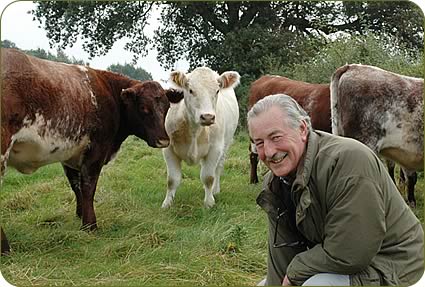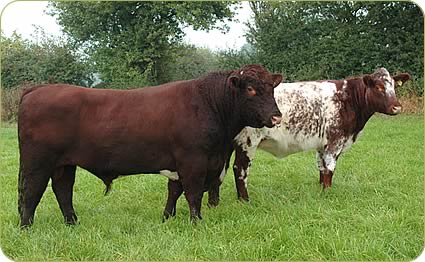Jennifer MacKenzie is an agricultural photo journalist with almost 30 year's experience. Operating from her base in Cumbria, Jennifer undertakes mainly industry-related freelance writing and photography.
Beef Shorthorn - a breed for the future
Gerald Turton is one of the Beef Shorthorn’s greatest enthusiasts, having done much to promote the breed.
Beef Shorthorn breeding was in the blood for Gerald Turton – the third generation of his family to run the North Yorkshire based Upsall herd, which is the oldest in the country and rapidly approaches its centenary.
 |
| Gerald Turton with Shorthorn heifers. |
The herd was established in 1909 by Gerald Turton’s great uncle Sir Edmund Turton, at the farms at Upsall, near Thirsk, when the Beef Shorthorn was in its hey day.
Gerald’s father, Robin Turton - Lord Tranmire - succeeded in the herd’s management as well as in his uncle’s footsteps as an MP for 45 years.
And since he took on the running of the 1,000-acre predominantly arable estate and the herd in 1960 there was never any doubt for Gerald Turton that he would continue with the breed – a later brush with the new imported continental breeds further strengthened his resolve.
Now, into the new millennium and another new era without headage subsidies for Britain’s beef farmers with the Single Farm Payment and lifting of the Over Thirty Month Scheme, he remains more convinced that the Beef Shorthorn’s attributes make it a breed for the future.
“Our aim has always been to produce the ideal suckler cow with bulls suitable for breeding suckler cows from continental females,” said Gerald.
“It’s very important to foresee the future and to see what is wanted by the commercial producer. The way farming is heading people will become more interested in quality.
“The Beef Shorthorn is a maternal breed which has unique traits and those who want decent suckler cows would be well advised to look to the Shorthorn to breed their own replacement females if they don’t want to buy them in.
“They make very good mothers and because of their wide pelvic bone they calve easily. They come to puberty earlier than other breeds and they do extremely well on poorer grazing ground.
 |
| The stock bull Watchman of Upsall, at 27 months, which had been running with 25 cows during the summer, wiht an -in-calf heifer. |
“Beef Shorthorns are also quiet and easy to manage – which are all traits which should be of particular importance now when people have less time.”
Another trait of the Shorthorn is its superior meat eating qualities and with an eye on the future and further marketing opportunities for the breed, Gerald has been involved with Merial’s Igenity L testing scheme.
From a few strands of hair, this identifies leptin protein which is directly related to appetite, energy utilisation - and marbling - in beef cattle with British breeds tending to marble and continental breeds tending to be lean.
“If beef is of inferior quality and people buy it thinking they will produce a lovely dinner and it doesn’t then they will buy chicken next time. The Beef Shorthorn has been identified as having particular tenderness qualities,” he said.
Currently, most of the herd’s surplus heifers and steers are sold at a premium to Roy Scott, of Garstang, who is developing substantial businesses in selling well matured, traditional breed beef to a discerning customer base.
Bulls are sold at 480-500kg at 13 months old with heifers finishing at 20 months to two years old.
Gerald has been involved with the development by Skipton-based consultants the Erskine Corporation LLP of a strategic marketing and action plan for traditional breed beef which have been reared on environmentally sensitive areas found throughout the north of England on behalf of the Yorkshire Dales National Park Authority and North Yorkshire County Council.
This has also had the support of celebrity chef Sophie Grigson, one of many leading cooks who are firmly behind the concept of traditional breed beef.
The Upsall herd has been performance recorded since 1996 and Gerald has also taken advantage of the Breedplan cattle recording system which was adopted last year by the Beef Shorthorn Cattle Society, together with five other British Breed Societies, The Aberdeen Angus, Belgian Blue, Hereford, Simmental and South Devons.
Breedplan was originally developed in Australia and is now in use by 80 breed societies covering eight species in 11 countries and the new initiative takes the dissemination of information to a new level with a wide range of performance-related figures and statistics instantly available on a dedicated web site.
The Upsall herd achieved probably its greatest success at the February 2005 Perth Bull Sales, when not only the supreme championship but all the male trophies fell to bulls with the Upsall prefix – and they had impressive performance records.
The intermediate and supreme champion was the roan bull Wyvis of Upsall by Uppermill Recto and has a terminal sire index of +16, selling for 7,500gns, 500gns short of the sale’s top price to Shetland Island farmer E Graham.
The senior champion was Warwick of Upsall (P), who with Wyvis won the best pair of bulls and with Warrior of Upsall the best group of three bulls. With Warlock of Upsall (P) another strong roan bull which was not shown, the bull team averaged £3,968.75.
The Upsall team, brought out by David Cormack, consisted of four bulls, three of which were shown, however, Chesterhall Farms who had bought Alexander of Upsall (P) a son of Loch Awe Lysander as a calf at the Upsall sale in 2003, won the reserve supreme, junior and polled championships with the bull.
On Breedplan weight figures, Wyvis was in the top 1 per cent for 200 and 600 days, Warwick was top 15 per cent for 200DW and 400DW, Warlock tops 1 per cent for 600 and 400DW and Warrior top 1 per cent for 600DW.
Bulls bred at Upsall are treated commercially with the aim of producing strong, active sires which are ready to go on and work on commercial suckler herds on terrain ranging from low ground to the high hills.
The herd run by stockman Laurence Fenton now numbers 80 down calvers with followers and females are calved at two years of age.
The polled herd was started in 1960 and is now 90 per cent polled, reducing the risk of needing to dehorn which is an extra chore.
 |
| A December-2004 born embryo heifer by WHR Sonny, one of the most popular bulls in America, with her surrogate mother. |
American and Australian Shorthorn bloodlines have been used on the herd as well as some Maine Anjou to give size and cleanness in the early days after Gerald took over the herd’s management.
The herd is also in the SAC health scheme.
Twenty years ago Gerald Turton was instrumental in forming the North of England Beef Shorthorn Association to encourage local breeders who mainly had small numbers as a forum for discussion.
An annual autumn sale has also been established by the club at Thirsk, in conjunction with Thirsk Auction Mart with this year’s sale held on Saturday October 29, following on from the autumn Perth sale on Monday October 24.

